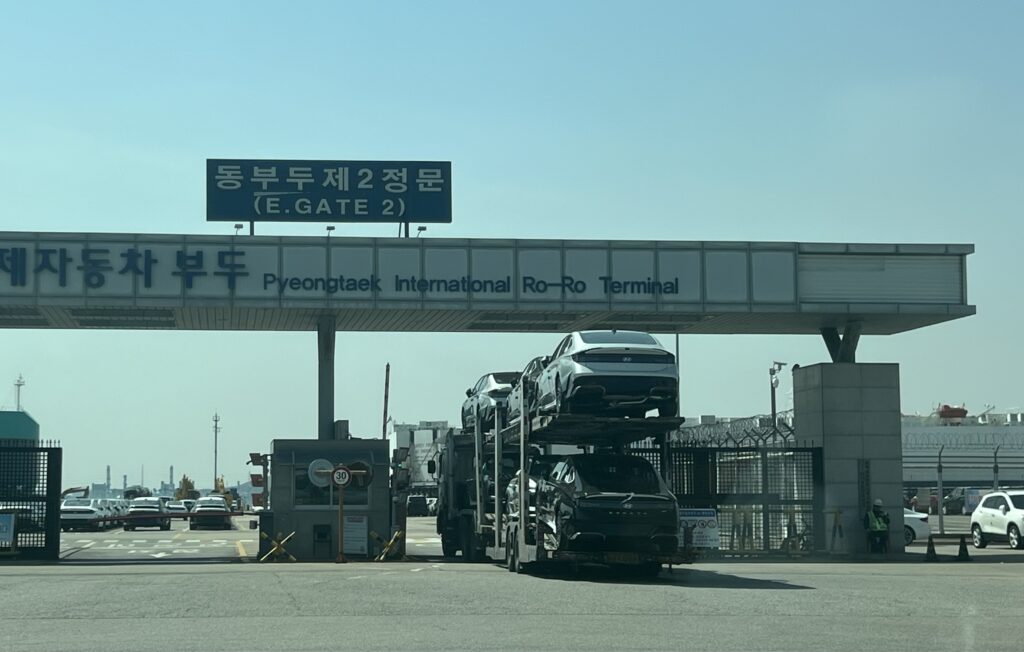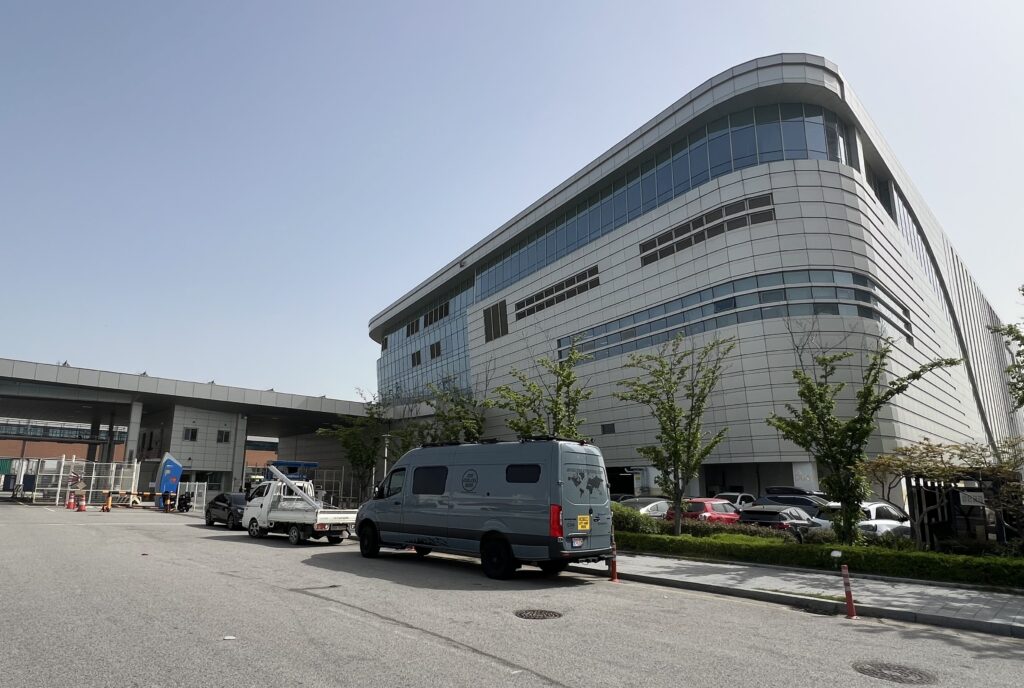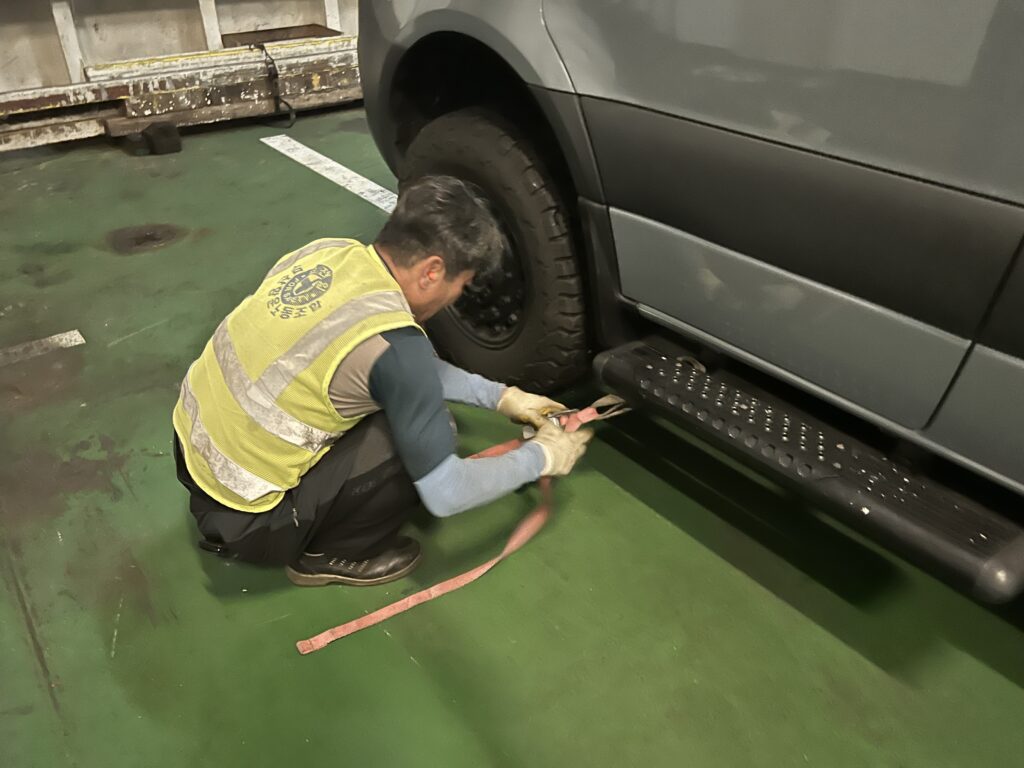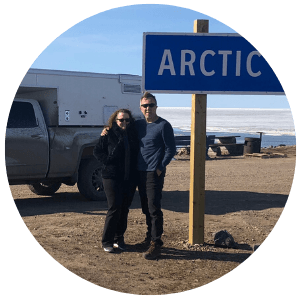What follows here is a review of the process of shipping our Mercedes Sprinter van from Australia to Korea ( February 2024 ) and then on from Korea to Japan ( April 2024 ). A warning – our regular blog readers will find minimal information of any interest in this edition ( unless the excruciating minutiae of shipping a vehicle captivates you ! ) – the detail is provided for those who may be looking to do something similar with a vehicle, either from Australia to Korea or onwards from Korea to Japan. A little payback ( or paying it forward ) for the many who helped guide us in this process in the past.

After spending all of 2023 and the early part of 2024 travelling around Australia in our Sprinter campervan, we shipped the van via RoRo from Melbourne to Pyeongtaek, Korea. We shipped via a Wallenius Wilhelmsen car carrier that stopped in Fremantle, Singapore, Laem Chabang ( Bangkok ) and Kunsan en route and took almost 30 days. After almost 4 weeks travelling with the van in Korea, we took the Camellia Line ferry from the port of Busan ( Korea ) to Fukuoka ( Japan ). We hope that the details below will offer some valuable insights ( we’ve included pricing and contact info ) to overlanders ( or anyone else ) contemplating shipping to or from these ports. I know I echo the thoughts of every overlander in saying that THE most stressful part of life on the road is dealing with shipping, especially collecting your vehicle, and specifically off a RoRo ship. Fortunately, this time ours is a good news story.

Australia to Korea
We used Anthony Paratore of Bullock’s Freightmaster in Fremantle. Anthony was timely, competitive and very reassuring throughout. Highly recommended. We shipped RoRo, on a Wallenius car carrier from Melbourne to Pyeongtaek in Korea ( about 30 days ). We took marine insurance through Stewart Insurance Group ( Michael/Anastasia ) who were also excellent and prompt. Quote was based on our vehicle’s value so no point quoting insurance premiums here. They were very competitive and used Zurich, a major global player. Drop off at the Port of Melbourne was fast and easy, we paid about $150AUD for the required port escort and were in and out in about 45 minutes.
Anthony referred us to YCL Logistics ( in Seoul ) to handle to collection process in Korea. They were professional, prompt with communication and gave us white glove treatment all the way. Not cheap, but very much full service ( pick up from hotel, driven 2 hours to Pyeongtaek for vehicle collection etc, etc ). Our experience was complicated by the fact that Wallenius changed our port of delivery from Masan to Pyeongtaek and this added some time and expense to the process. No one’s fault, *&$# happens ! Kunsan, Incheon and Masan are far more commonly used and would have saved us some money certainly.
This is now our 4th international shipment ( 1 x container, 3 x RoRo ) and while the broad process is identical there are unique aspects of each that merit attention. In respect of Korea I should add this; while I can’t say it with absolute certainty I’m quite sure the majority who visit with their own vehicles come by ferry from one of Japan ( several port options ), Russia ( Vladivostok ) or China ( Dalian/Tianjin ). It seems that in the case of ferry arrivals ( vs RoRo carriers or container ships ) the port procedures and customs clearance processes are far simpler ( and hence far cheaper ). Our experience was on a RoRo carrier, from Melbourne ( Australia ) so the clearance procedures were quite a bit more involved and hence more expensive (we also got “white glove” treatment – just the way our Korean contacts worked which undoubtedly added to our costs ). I’m sure it could be done for less if one handled some of the process oneself ( as we’ve done ourselves in other ports ).
Costs:
We had exceptional service from Anthony Paratore at Bullocks in Fremantle and would highly recommend him. For a 42cbm vehicle we paid $4,970 AUD ( approx. $US 3,230 ) from Australia to Korea – this included shipping freight and all port charges in Australia except the port escort in Melbourne ( approx. $150 AUD). Vehicle insurance is extra and no point in me quoting it here because it’s based largely on vehicle value so will vary enormously. Michael at Stewart’s in Melbourne was very competitive with a policy from Zurich Marine – and super fast.
At the Korean end YCL also served us very well. Super people with multiple English speaking contacts ( JB, Emily and James ) and very “full service” but as a result they are not cheap. We paid $US 1,100 to pick up our van in Pyeongtaek when all various charges were added. Two things ( no one’s fault ) compounded the costs. Firstly, Korean Customs at Pyongtaek do not often handle individual vehicles (we were told ) and simply were not sure of some of the processes. They had to consult with the folks at Incheon and Masan in order to complete our clearance. At one point they even suggested that it may be required to bond our vehicle, place it on a flatbed truck and drive it to Busan since that is the port we intended to exit from and according to their understanding, we should enter and exit through the same port ! Our agent talked them out of that nonsense. Had the ship stuck to its original discharge destination I have no doubt the process would have cost less. According to our shipping agent, Incheon was the best port to enter Korea through if one had a choice ( we didn’t ! ).

That all said, the pick up process at Pyongtaek was incredibly easy and very fast. About 45 minutes. Only in Brunswick, Georgia ( in the US ) have we seen a vehicle released faster and with less fuss – about 30 minutes ( a striking contrast to our experience trying to clear the vehicle out of Melbourne when it first went to Australia !!). No one looked at the vehicle with us, no one checked that we had insurance (we did have it) – some basic ID checks, hi-viz vest and hard hat worn, proof of fees paid and we were on our way. All done digitally, practically no paper. So simple.
What Went Well:
Well, the most important thing of course – we got our vehicle in perfect condition with no damage and (critically) NO THEFT ! I went to extreme lengths to ensure that everything of value that was left in the van was secured in the garage compartment under our bed and that it was able to be locked separately from the rest of the van. Unless customs wanted to check it when it arrived in Korea ( which I could facilitate ) there was no way port staff or ship-board crew could access our stuff. No one ( from the port staff ) accompanied us to the van when we collected it ( just my agent and I ). Fortunately no one in Melbourne made us unlock that area of the vehicle when we dropped it there ( in some ports they do ). This was a huge relief based on two significant thefts on past RoRo transits.

What Did Not:
While originally routed from Melbourne to Masan ( in the south of South Korea ), once at sea the shipping line changed our unloading port to Pyeongtaek ( nearer to Seoul ). This caused hassles and costs for our agents, and we were stuck dealing with a port not familiar with what we were doing.
Summary:
We felt the shipping cost to Korea was excellent value given typical shipping costs these days. We felt the clearing costs in Korea ( on our particular shipment ) were higher than normal ( partly for reasons noted above ). It cost more than twice as much to clear our van in Korea than it cost to clear our vehicle in Brunswick, Georgia just 2 years earlier. I would have expected costs in the US to be higher than Korea; not so ! I would not assume these costs we paid to be normal, however, and am sure it could be done for well under $1,000 at other Korean ports. We know of people that paid considerably less than us.
Korea To Japan
We chose the Camellia Line ferry to transport our van from Busan ( Korea ) to Fukuoka ( Japan ). I cannot speak highly enough about this company. They did an excellent job from start to finish and we would recommend them highly. We booked it all via email through YJ Choi of the Busan office ( yjchoi@koreaferry.kr ). The ferry was on time ( arrived early in fact ) and they were super well organized from A to Z. Staff at the office spoke English, as did their port staff and staff on the ship. We were personally escorted to the ship with our van, through customs in Korea and again in Japan. They explained exactly what documents we needed ( passport, Carnet, Int’l Drivers Licence, and vehicle registration documents). They took care of issuing the basic Third Party Insurance needed to get road-ready in Japan and directed us to the JAF ( Japan Autombile Federation ) office in Fukuoka for Carnet validation.


Costs:


Costs:
We paid 726,000 Korean won ( $537 USD ) to ship our 3.5 tonne, 42cbm van along with driver, passenger and a 2 berth deluxe private cabin with its own shower and toilet ( 536,000 for the van and driver, 90,000 for the passenger, and 100,000 for the cabin ). In Japan we paid approx. ¥32,700 ($212 USD) in charges – ¥5,000 port fees, ¥3,000 Carnet validation at JAF, ¥16,000 Surety Deposit at Japan Customs and ¥7,700 mandatory Third Party Insurance for the van. Camellia Line had a good reputation, was used by others we knew of and sails on the shortest route from Korea to Japan. I believe the Pukwan ferry carries vehicles as well but sails to Osaka ( further, and more expensive ). For those interested there are also ferries from Korea to Russia ( Vladivostok) and Korea to China ( Dalian ) although the Russian one may not be running at present.

What went well:
Everything, until we got to Fukuoka where the delays at Japan Customs cost us many hours of wasted time. It was a very long day ! Throughout the delays in Japan the Camellia staff were excellent. They could not apologize enough. The actual customs inspection in Japan was cursory- they barely looked inside and never even opened the rear doors. They seemed more interested in our trip around Australia and Korea than anything else ! On that note, the customs inspection in Korea was very basic as well. Super fast and easy.

What did not:
It was a long wait at the terminal in Fukuoka for the Carnet to be processed.and documents signed. And then more signed, and then more when I asked that Lois be allowed to drive the car as well. Supposedly, if arriving in Japan by ferry, one is not “required” to have a Carnet but that was never presented to us an option – they asked us right from the beginning about the Carnet so we never explored the TIP option. I will ask more about that and update this section if I find out further information on it, it may have been an easier way to go.


Summary:
We would highly recommend this route to Japan. Comfortable ferry, smooth crossing, well priced and very well organized. We had briefly considered shipping directly from Australia to Japan but decided to include Korea on the route for a few reasons; there was much of it we had never seen before, what we had seen had changed a lot in 40 years, and finally, we knew that the ferry crossing from Korea to Japan was quick, easy and ended up being even less expensive than we thought. It’s also a less popular destination for overland travellers which provided a more unique experience. For only an additional $US700 or so it was a very small price to pay to include both countries on our itinerary, and we are very glad we did.
What Next :
We are now in Japan and excited to begin exploring the “Land of the Rising Sun”. We will shortly start making plans to confirm space on a ship out of Japan for later this ( northern ) summer. Details on that once we have them.
Till next shipment…….!


